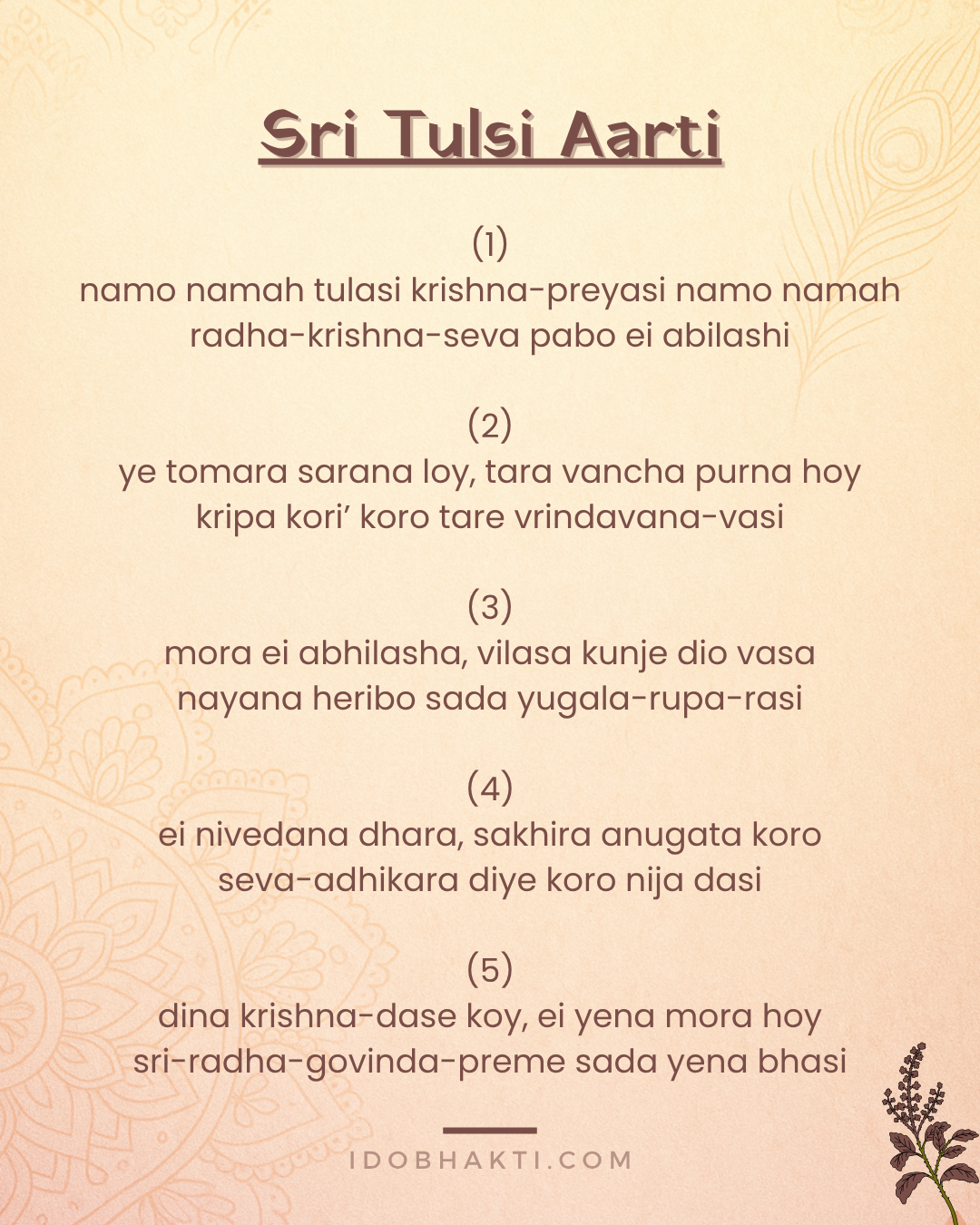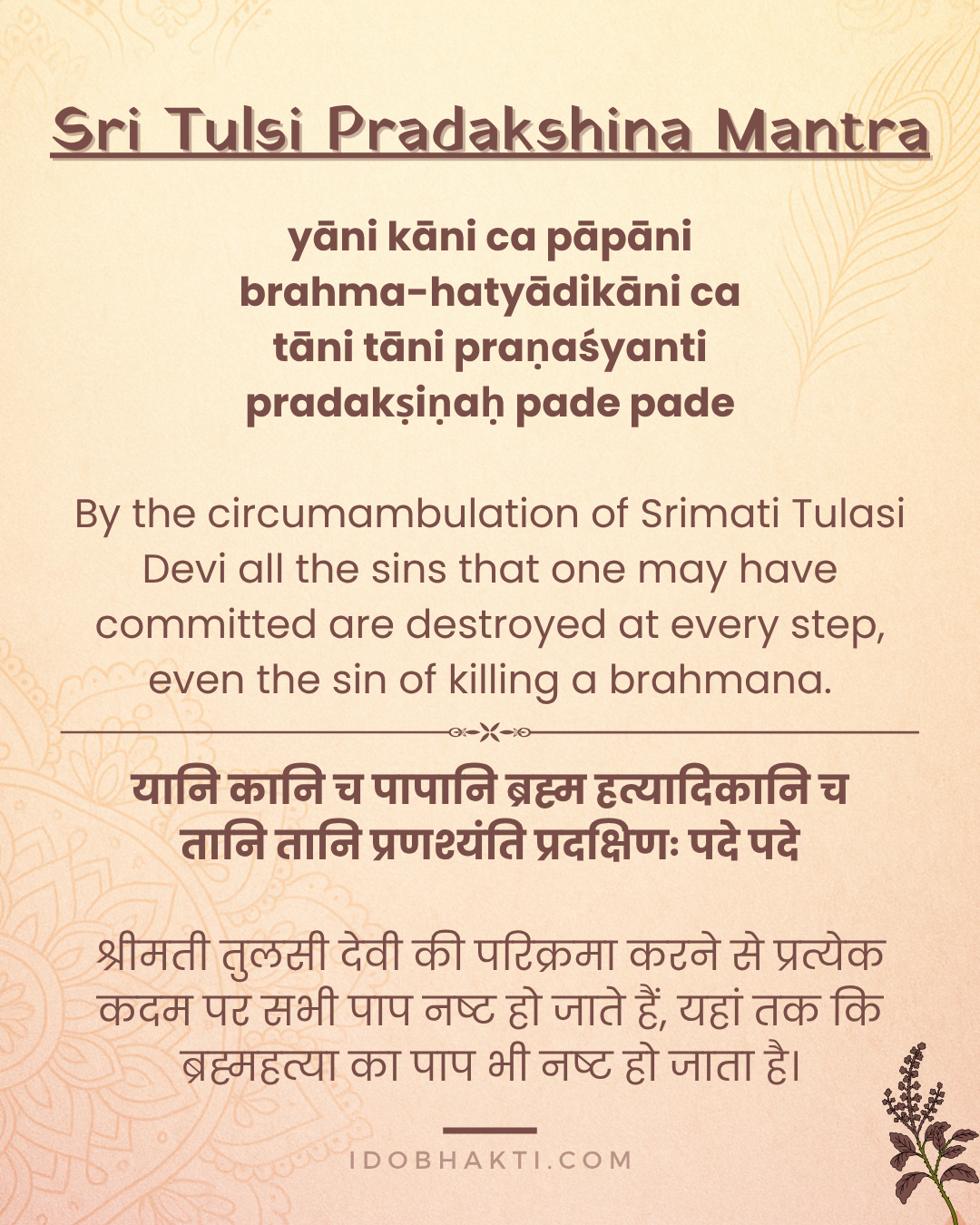


Tulsi Aarti – Sacred Prayer to Goddess Tulsi
Tulsi Aarti is a devotional hymn dedicated to Goddess Tulsi, the sacred plant revered as the consort of Lord Vishnu. Chanting this aarti with faith brings purity, prosperity, and divine blessings into one’s home. It glorifies Tulsi Devi’s unmatched devotion and her power to bestow spiritual and material well-being on devotees.

Sri Tulsi Aarti: The Divine Worship of the Beloved of Krishna
By Krishnadasa Kaviraja Goswami
Tulsi Devi, also known as Vrinda Devi, holds a unique and exalted position in the Vaishnava tradition. She is not merely a sacred plant but a divine personality—an eternal associate of Lord Krishna who plays an essential role in His transcendental pastimes. The daily worship of Tulsi Devi, especially through the recitation of Sri Tulsi Aarti and Tulsi Pranama, is an integral part of the devotional life of every ISKCON devotee and follower of Sanatana Dharma.
Let us explore the meaning, significance, and spiritual depth of the Tulsi Aarti, its origins, and how devotees can connect more intimately with Tulsi Maharani through this sacred offering.
The Glory of Tulsi Devi
In the scriptures, Tulsi Devi is glorified as the most sacred of all plants. She is a divine expansion of the goddess of devotion, who grants pure love of Krishna (Krishna-bhakti) to those who serve her with faith and humility.
In the Padma Purana, Lord Vishnu declares:
“Tulasi is most dear to Me. Without Tulasi leaves, I do not accept any offering.”
This statement alone reveals the magnitude of Tulsi Devi’s importance in Vaishnava worship. Every offering to Krishna—be it fruits, sweets, or flowers—is considered incomplete unless adorned with a Tulsi leaf. The Tulsi plant, therefore, stands as a bridge between the devotee and the Supreme Lord, connecting the material and spiritual realms.
Sri Tulsi-Aarti (By Krishnadasa Kaviraja Goswami)
(1)
namo namah tulasi krishna-preyasi namo namah
radha-krishna-seva pabo ei abilashi
Translation:
O Tulsi, beloved of Lord Krishna, I bow before you again and again. My heartfelt desire is to obtain the service of Sri Sri Radha and Krishna.
This opening verse is a humble offering of obeisance to Tulsi Devi. The devotee recognizes her as the most beloved of Krishna and expresses the ultimate aspiration—to serve Radha and Krishna in Their eternal pastimes. By surrendering to Tulsi, one gains access to the divine couple’s service, for she is the gateway to Vrindavana’s spiritual world.
(2)
ye tomara sarana loy, tara vancha purna hoy
kripa kori’ koro tare vrindavana-vasi
Translation:
Whoever takes shelter of you, O Tulsi, has all his desires fulfilled. Bestowing your mercy upon him, you make him a resident of Vrindavana.
Tulsi Devi is described here as the merciful benefactress who grants residence in Vrindavana-dhama, the eternal abode of Lord Krishna. To live in Vrindavana—either physically or through consciousness—is to live in the spiritual world. Those who serve Tulsi Devi with sincerity are spiritually transported to Vrindavana, even while living in this world.
(3)
mora ei abhilasha, vilasa kunje dio vasa
nayana heribo sada yugala-rupa-rasi
Translation:
My desire is that you will grant me residence in the pleasure groves of Vrindavana, where I may always behold the beautiful pastimes of Radha and Krishna.
Here, the devotee prays for a permanent place in Vrindavana’s divine groves (vilasa kunjas), where Radha and Krishna perform Their eternal lilas (pastimes). The devotee’s eyes yearn to constantly behold Their beautiful forms—forever absorbed in the sweetness of divine love. Tulsi Devi, as the embodiment of devotion, has the power to grant this vision to sincere souls.
(4)
ei nivedana dhara, sakhira anugata koro
seva-adhikara diye koro nija dasi
Translation:
I beg you, O Tulsi, please make me a follower of the gopis, the dear cowherd maidens of Vraja. Give me the privilege of devotional service and make me your own maidservant.
The devotee here expresses the highest aspiration—to serve Radha and Krishna under the guidance of the gopis of Vraja. Tulsi Devi herself is one of the foremost gopi attendants, eternally assisting in the divine pastimes. To become her servant is to enter the confidential circle of service to the divine couple.
(5)
dina krishna-dase koy, ei yena mora hoy
sri-radha-govinda-preme sada yena bhasi
Translation:
This very fallen servant of Krishna prays: “May I always swim in the ocean of love for Sri Radha and Govinda.”
The final verse concludes the Aarti with a prayer for eternal absorption in divine love. The devotee identifies as “dina”—humble and fallen—yet aspires to constantly float in the waves of Radha-Govinda’s prema (divine love). This humility is the true ornament of a Vaishnava, for through sincere humility, one attracts the mercy of both Tulsi Devi and Krishna.


Meaning and Significance of Tulsi Aarti
1. A Symbol of Pure Devotion
Tulsi Devi represents the purest form of devotion—completely selfless and centered on pleasing Krishna. Performing her Aarti helps devotees cultivate these same qualities within their hearts.
2. Gateway to Vrindavana
Tulsi is the gateway to Krishna’s divine abode. By worshiping her daily, devotees spiritually reside in Vrindavana, even while living far from it.
3. Destroyer of Sins
Scriptures state that simply seeing, touching, or circumambulating the Tulsi plant destroys lifetimes of sins. Offering a single leaf with devotion can liberate one from material bondage.
4. Enhances Bhakti (Devotion)
Every act of service to Tulsi Devi—watering, cleaning her area, offering lamps, or singing her praises—increases one’s bhakti manifold. Tulsi is known as “Bhakti-prada Devi,” the giver of devotion.
5. Connection to Radha-Krishna
Tulsi Aarti constantly reminds devotees that the ultimate goal of life is not material success or liberation but loving service to Radha and Krishna. Tulsi grants access to that sacred service.


Tulsi Pranama Mantra
Before performing Aarti or offering Tulsi leaves, devotees recite the following pranam mantra:
Transliteration:
vṛndāyai tulasī-devyai
priyāyai keśavasya ca
viṣṇu-bhakti-prade devī
satya vaṭyai namo namaḥ
Translation:
I offer my repeated obeisances unto Vrinda, Srimati Tulsi Devi, who is very dear to Lord Kesava. O goddess, you bestow devotional service to Krishna and you embody the highest truth.
This mantra acknowledges Tulsi Devi as Vrinda Devi, the queen of Vrindavana, who oversees the arrangement of Krishna’s pastimes. She is not just a plant but a divine personification of devotion.
Tulsi Leaf Collection Mantra
When devotees collect leaves from the Tulsi plant (for offering to Krishna), they do so with great reverence while chanting:
Transliteration:
tulasy amṛta-janmāsi
sadā tvaṁ keśava-priyā
keśavārthaṁ cinomi tvāṁ
varadā bhava śobhane
Translation:
O Tulsi, you were born from nectar, and you are always dear to Lord Kesava. I pluck your leaves for the service of Lord Kesava; please be merciful and grant me this boon.
This mantra reflects the deep respect and awareness devotees must have while engaging with Tulsi Devi. Her leaves are sacred, and they must never be cut or plucked carelessly. Devotees only collect them in the morning and never at night or on specific fasting days.
How to Perform Tulsi Aarti
Performing Tulsi Aarti is a simple yet deeply spiritual act. Here is the general ISKCON-guided procedure:
1. Preparation
-
Place the Tulsi plant on a clean altar or raised platform.
-
Light incense and a ghee lamp.
-
Offer flowers, water, and Tulsi leaves.
-
Ring the bell gently to announce the beginning of Aarti.
2. Chant Tulsi Pranama
Begin by offering obeisances and chanting the Tulsi Pranama Mantra three times.
3. Sing Tulsi Aarti
Devotees sing “Namo Namah Tulasi Krishna-preyasi Namo Namah” together, accompanied by mridanga, kartals, and joyful clapping.
4. Offer Aarti Items
Wave the lamp, incense, flower, and water before Tulsi Devi in circular motions, symbolizing the surrender of all the elements of the body and soul.
5. Circumambulation
After the Aarti, devotees circumambulate Tulsi Devi four times while chanting:
yani kani cha papani
brahma-hatyadikani cha
tani tani pranashyanti
pradakshina pade pade
Meaning:
By circumambulating Tulsi Devi, all sins—including the greatest of sins—are destroyed at every step.


Spiritual Benefits of Worshiping Tulsi Devi
-
Attainment of Pure Bhakti:
Tulsi Devi bestows the gift of pure devotional service upon her worshippers, removing the obstacles that block the path of love for Krishna. -
Freedom from Material Suffering:
Serving Tulsi brings peace, removes anxieties, and purifies the heart from lust, anger, and greed. -
Liberation from Sins:
Even a single circumambulation or offering of a Tulsi leaf cleanses one from lifetimes of sinful reactions. -
Protection from Negativity:
Keeping a Tulsi plant at home purifies the atmosphere and shields the household from inauspicious energies. -
Blessings of Vrindavana:
Those who daily serve Tulsi Devi receive the same spiritual merit as living in Vrindavana.
The Divine Form of Tulsi Devi
Tulsi Devi is described in scriptures as a celestial goddess adorned with green garments and a golden complexion. Her crown is decorated with blooming flowers, and she radiates compassion. She holds a lotus and symbolizes divine surrender. In her earthly form as the Tulsi plant, she allows devotees to tangibly serve and worship her in daily life.
Tulsi in ISKCON Tradition
In ISKCON temples worldwide, the worship of Tulsi Devi is performed every morning and evening. The Aarti is sung in a congregational mood, followed by circumambulation and chanting of the Hare Krishna Mahamantra. Srila Prabhupada, the founder-acharya of ISKCON, emphasized that Tulsi worship is not symbolic but a real interaction with a divine personality.
He once said:
“Tulsi Devi is a pure devotee of Krishna and should be treated with the same respect as any devotee. When we offer Tulsi leaves to the Lord, He becomes very pleased.”
The Symbolism of Tulsi in Devotional Life
-
Faith (Shraddha): Tulsi Devi nurtures the seed of faith in the heart of the devotee.
-
Purity (Shuddhata): Her presence sanctifies the home, mind, and body.
-
Service (Seva): She represents the ideal mood of selfless service to Krishna.
-
Compassion (Karuna): Tulsi Devi is the embodiment of mercy, uplifting even the most fallen souls.
The Inner Meaning of the Aarti
Each verse of the Tulsi Aarti symbolizes a stage in the journey of devotion:
-
Verse 1: Surrender and the desire for divine service.
-
Verse 2: Dependence on Tulsi’s mercy for spiritual fulfillment.
-
Verse 3: Aspiration for residence in the spiritual realm.
-
Verse 4: The prayer for eternal service under divine guidance.
-
Verse 5: The final union with divine love, Radha-Govinda prema.
Through these verses, the devotee moves from external worship to inner transformation—culminating in pure love of God.
Practical Tips for Tulsi Worship at Home
-
Keep the Tulsi plant clean and healthy. Avoid touching her with unwashed hands.
-
Offer water daily (except on Dwadashi days).
-
Never pluck leaves at night or during sacred times like Ekadashi or Dwadashi.
-
Offer a lamp or ghee diya during morning and evening prayers.
-
Chant her Aarti with devotion, even if alone—her blessings multiply through sincere intent.
Conclusion: The Heart of Devotion
Worshiping Tulsi Devi is more than a ritual—it is a sacred relationship. She is the pure devotee who connects the soul to Krishna, the embodiment of divine love and mercy. By bowing before her, chanting her prayers, and serving her daily, a devotee opens the doors to the eternal Vrindavana within the heart.
As Krishnadasa Kaviraja Goswami beautifully expresses in his Aarti, the ultimate goal is to serve Radha and Krishna under Tulsi’s merciful guidance and to forever float in the ocean of divine love.
Hare Krishna
Jaya Tulsi Maharani Ki Jai!
Jaya Vrinda Devi Ki Jai!
Jaya Sri Radha-Krishna Ki Jai!




